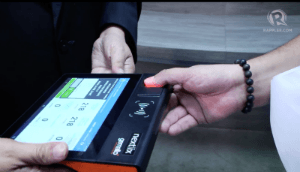SUMMARY
This is AI generated summarization, which may have errors. For context, always refer to the full article.

MANILA, Philippines – In a bid to deter illegal voters, the Commission on Elections (Comelec) will deploy its new voter registration verification machines (VRVM) or fingerprint scanning technology for the first time on election day, May 13.
Comelec Spokesperson James Jimenez earlier said deploying VRVMs was part of the agency’s efforts to thwart “flying voters” or those who will try to vote in more than one precinct.
The VRVMs will be launched in only a few test sites in the upcoming May 2019 polls. It makes use of live fingerprint scanning technology to verify a voter’s identity and determine whether or not he or she is registered in a certain precinct. (READ: What voters need to know about Comelec’s fingerprint verification machine)
Comelec Resolution 10522 lists the following 14 areas where the VRVMs will be piloted tested on election day, May 13:
- Manila
- Quezon City
- Davao City
- Pangasinan (including all cities)
- Cavite (including all cities)
- Cebu (including all cities)
- Negros Occidental (including all cities)
- Zamboanga del Sur (including all cities)
- Davao del Sur (including all cities)
- Bangsamoro Autonomous Region in Muslim Mindanao
- Caloocan City
- Iloilo (including all cities)
- Nueva Ecija (including all cities)
- Misamis Oriental (including all cities)
If you’re a voter in one of these areas, here are some things to expect:
STEP 1: Teachers, who serve as members of the BEI, will first ask for your name to check if you are part of the list of voters crossed out from the voters’ list.
Voters whose names are part of the crossed-out list include those who have transferred precincts, registered multiple times, died, or have been excluded by a court. In such cases, those part of this list will not be allowed to vote.
Once this is done, individuals who are not on the crossed-out list will have their fingerprints scanned on the VRVM.
STEP 2: To verify your fingerprint, place your thumb or index finger on the machine’s scanner until its red light disappears.
If scanning fails, try again with another finger used to register your biometric data during the Comelec’s voter registration. Fingerprint scanning can be done up to a maximum of 4 times.
If on the fourth try scanning still fails, don’t leave – this doesn’t mean you can’t vote. The poll clerk will proceed with manual verification.
STEP 3: Once verified by the VRVM, a verification receipt will be printed.
Poll clerks will give you the receipt, which you will need to present to the chairperson of the BEI.
After presenting your receipt, the chairperson will issue you a ballot, a ballot secrecy folder, and marking pen.
Take note, a verification receipt can only be printed once, so don’t lose it. Receipts also cannot be taken outside of polling places.
Once this is done, you’re ready to vote!
The Comelec said if things go smoothly during the VRVMs’ pilot run, it may use the machines nationwide for the 2022 presidential elections. – Rappler.com
Add a comment
How does this make you feel?
There are no comments yet. Add your comment to start the conversation.